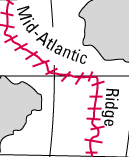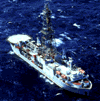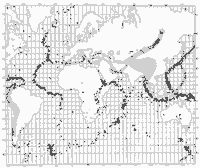

Continental drift was hotly debated off and on for decades following Wegener's
death before it was largely dismissed as being eccentric, preposterous,
and improbable. However, beginning in the 1950s, a wealth of new evidence
emerged to revive the debate about Wegener's provocative ideas and their
implications. In particular, four major scientific developments spurred
the formulation of the plate-tectonics theory: (1) demonstration of the
ruggedness and youth of the ocean floor; (2) confirmation of repeated reversals
of the Earth magnetic field in the geologic past; (3) emergence of the seafloor-spreading
hypothesis and associated recycling of oceanic crust; and (4) precise documentation
that the world's earthquake and volcanic activity is concentrated along
oceanic trenches and submarine mountain ranges.
Ocean floor mapping
About two thirds of the Earth's surface lies beneath the oceans. Before
the 19th century, the depths of the open ocean were largely a matter of
speculation, and most people thought that the ocean floor was relatively
flat and featureless. However, as early as the 16th century, a few intrepid
navigators, by taking soundings with hand lines, found that the open ocean
can differ considerably in depth, showing that the ocean floor was not as
flat as generally believed. Oceanic exploration during the next centuries
dramatically improved our knowledge of the ocean floor. We now know that
most of the geologic processes occurring on land are linked, directly or
indirectly, to the dynamics of the ocean floor.
"Modern" measurements of ocean depths greatly increased in the
19th century, when deep-sea line soundings (bathymetric surveys)
were routinely made in the Atlantic and Caribbean. In 1855, a bathymetric
chart published by U.S. Navy Lieutenant Matthew Maury revealed the first
evidence of underwater mountains in the central Atlantic (which he called
"Middle Ground"). This was later confirmed by survey ships laying
the trans-Atlantic telegraph cable. Our picture of the ocean floor greatly
sharpened after World War I (1914-18), when echo-sounding devices -- primitive
sonar systems -- began to measure ocean depth by recording the time it took
for a sound signal (commonly an electrically generated "ping")
from the ship to bounce off the ocean floor and return. Time graphs of the
returned signals revealed that the ocean floor was much more rugged than
previously thought. Such echo-sounding measurements clearly demonstrated
the continuity and roughness of the submarine mountain chain in the central
Atlantic (later called the Mid-Atlantic Ridge) suggested by the earlier
bathymetric measurements.
In 1947, seismologists on the U.S. research ship Atlantis found that
the sediment layer on the floor of the Atlantic was much thinner than originally
thought. Scientists had previously believed that the oceans have existed
for at least 4 billion years, so therefore the sediment layer should have
been very thick. Why then was there so little accumulation of sedimentary
rock and debris on the ocean floor? The answer to this question, which came
after further exploration, would prove to be vital to advancing the concept
of plate tectonics.
In the 1950s, oceanic exploration greatly expanded. Data gathered by oceanographic
surveys conducted by many nations led to the discovery that a great mountain
range on the ocean floor virtually encircled the Earth. Called the global
mid-ocean ridge, this immense submarine mountain chain -- more than
50,000 kilometers (km) long and, in places, more than 800 km across -- zig-zags
between the continents, winding its way around the globe like the seam on
a baseball. Rising an average of about 4,500 meters(m) above the sea floor,
the mid-ocean ridge overshadows all the mountains in the United States except
for Mount McKinley (Denali) in Alaska (6,194 m). Though hidden beneath the
ocean surface, the global mid-ocean ridge system is the most prominent topographic
feature on the surface of our planet.
Magnetic striping and polar reversals
Beginning in the 1950s, scientists, using magnetic instruments (magnetometers)
adapted from airborne devices developed during World War II to detect submarines,
began recognizing odd magnetic variations across the ocean floor. This finding,
though unexpected, was not entirely surprising because it was known that
basalt -- the iron-rich, volcanic rock making up the ocean floor--
contains a strongly magnetic mineral (magnetite) and can locally
distort compass readings. This distortion was recognized by Icelandic mariners
as early as the late 18th century. More important, because the presence
of magnetite gives the basalt measurable magnetic properties, these newly
discovered magnetic variations provided another means to study the deep
ocean floor.

A theoretical model of the formation of magnetic striping.
New oceanic crust forming continuously at the crest of the mid-ocean ridge
cools and becomes increasingly older as it moves away from the ridge crest
with seafloor spreading (see text): a. the spreading ridge about
5 million years ago; b. about 2 to 3 million years ago; and c.
present-day.
Early in the 20th century, paleomagnetists (those who study the Earth's
ancient magnetic field) -- such as Bernard Brunhes in France (in 1906) and
Motonari Matuyama in Japan (in the 1920s) -- recognized that rocks generally
belong to two groups according to their magnetic properties. One group has
so-called normal polarity, characterized by the magnetic minerals
in the rock having the same polarity as that of the Earth's present magnetic
field. This would result in the north end of the rock's "compass
needle" pointing toward magnetic north. The other group, however,
has reversed polarity, indicated by a polarity alignment opposite
to that of the Earth's present magnetic field. In this case, the north
end of the rock's compass needle would point south. How could this
be? This answer lies in the magnetite in volcanic rock. Grains of magnetite
-- behaving like little magnets -- can align themselves with the orientation
of the Earth's magnetic field. When magma (molten rock containing
minerals and gases) cools to form solid volcanic rock, the alignment of
the magnetite grains is "locked in," recording the Earth's magnetic
orientation or polarity (normal or reversed) at the time of cooling.
As more and more of the seafloor was mapped during the 1950s, the magnetic
variations turned out not to be random or isolated occurrences, but instead
revealed recognizable patterns. When these magnetic patterns were mapped
over a wide region, the ocean floor showed a zebra-like pattern. Alternating
stripes of magnetically different rock were laid out in rows on either side
of the mid-ocean ridge: one stripe with normal polarity and the adjoining
stripe with reversed polarity. The overall pattern, defined by these alternating
bands of normally and reversely polarized rock, became known as magnetic
striping.
Seafloor spreading and recycling of oceanic crust
The discovery of magnetic striping naturally prompted more questions: How
does the magnetic striping pattern form? And why are the stripes symmetrical
around the crests of the mid-ocean ridges? These questions could not be
answered without also knowing the significance of these ridges. In 1961,
scientists began to theorize that mid-ocean ridges mark structurally weak
zones where the ocean floor was being ripped in two lengthwise along the
ridge crest. New magma from deep within the Earth rises easily through these
weak zones and eventually erupts along the crest of the ridges to create
new oceanic crust. This process, later called seafloor spreading, operating
over many millions of years has built the 50,000 km-long system of mid-ocean
ridges. This hypothesis was supported by several lines of evidence: (1)
at or near the crest of the ridge, the rocks are very young, and they become
progressively older away from the ridge crest; (2) the youngest rocks at
the ridge crest always have present-day (normal) polarity; and (3) stripes
of rock parallel to the ridge crest alternated in magnetic polarity (normal-reversed-normal,
etc.), suggesting that the Earth's magnetic field has flip-flopped many
times. By explaining both the zebralike magnetic striping and the construction
of the mid-ocean ridge system, the seafloor spreading hypothesis quickly
gained converts and represented another major advance in the development
of the plate-tectonics theory. Furthermore, the oceanic crust now came to
be appreciated as a natural "tape recording" of the history of
the reversals in the Earth's magnetic field.
Additional evidence of seafloor spreading came from an unexpected source:
petroleum exploration. In the years following World War II, continental
oil reserves were being depleted rapidly and the search for offshore oil
was on. To conduct offshore exploration, oil companies built ships equipped
with a special drilling rig and the capacity to carry many kilometers of
drill pipe. This basic idea later was adapted in constructing a research
vessel, named the Glomar Challenger, designed specifically for marine
geology studies, including the collection of drill-core samples from the
deep ocean floor. In 1968, the vessel embarked on a year-long scientific
expedition, criss-crossing the Mid-Atlantic Ridge between South America
and Africa and drilling core samples at specific locations. When the ages
of the samples were determined by paleontologic and isotopic dating studies,
they provided the clinching evidence that proved the seafloor spreading
hypothesis.
A profound consequence of seafloor spreading is that new crust was, and
is now, being continually created along the oceanic ridges. This idea found
great favor with some scientists who claimed that the shifting of the continents
can be simply explained by a large increase in size of the Earth since its
formation. However, this so-called "expanding Earth" hypothesis
was unsatisfactory because its supporters could offer no convincing geologic
mechanism to produce such a huge, sudden expansion. Most geologists believe
that the Earth has changed little, if at all, in size since its formation
4.6 billion years ago, raising a key question: how can new crust be continuously
added along the oceanic ridges without increasing the size of the Earth?
This question particularly intrigued Harry H. Hess, a Princeton University
geologist and a Naval Reserve Rear Admiral, and Robert S. Dietz, a scientist
with the U.S. Coast and Geodetic Survey who first coined the term seafloor
spreading. Dietz and Hess were among the small handful who really understood
the broad implications of sea floor spreading. If the Earth's crust was
expanding along the oceanic ridges, Hess reasoned, it must be shrinking
elsewhere. He suggested that new oceanic crust continuously spread away
from the ridges in a conveyor belt-like motion. Many millions of years later,
the oceanic crust eventually descends into the oceanic trenches --
very deep, narrow canyons along the rim of the Pacific Ocean basin. According
to Hess, the Atlantic Ocean was expanding while the Pacific Ocean was shrinking.
As old oceanic crust was consumed in the trenches, new magma rose and erupted
along the spreading ridges to form new crust. In effect, the ocean basins
were perpetually being "recycled," with the creation of new crust
and the destruction of old oceanic lithosphere occurring simultaneously.
Thus, Hess' ideas neatly explained why the Earth does not get bigger with
sea floor spreading, why there is so little sediment accumulation on the
ocean floor, and why oceanic rocks are much younger than continental rocks.
Concentration of earthquakes
During the 20th century, improvements in seismic instrumentation and greater
use of earthquake-recording instruments (seismographs) worldwide
enabled scientists to learn that earthquakes tend to be concentrated in
certain areas, most notably along the oceanic trenches and spreading ridges.
By the late 1920s, seismologists were beginning to identify several prominent
earthquake zones parallel to the trenches that typically were inclined 40-60°
from the horizontal and extended several hundred kilometers into the Earth.
These zones later became known as Wadati-Benioff zones, or simply
Benioff zones, in honor of the seismologists who first recognized
them, Kiyoo Wadati of Japan and Hugo Benioff of the United States. The study
of global seismicity greatly advanced in the 1960s with the establishment
of the Worldwide Standardized Seismograph Network (WWSSN) to monitor the
compliance of the 1963 treaty banning above-ground testing of nuclear weapons.
The much-improved data from the WWSSN instruments allowed seismologists
to map precisely the zones of earthquake concentration worldwide.
But what was the significance of the connection between earthquakes and
oceanic trenches and ridges? The recognition of such a connection helped
confirm the seafloor-spreading hypothesis by pin-pointing the zones where
Hess had predicted oceanic crust is being generated (along the ridges) and
the zones where oceanic lithosphere sinks back into the mantle (beneath
the trenches).





 The
Mid-Ocean Ridge [70 k]
The
Mid-Ocean Ridge [70 k] Computer-generated topographic map
of the Mid-Ocean Ridge [55 k]
Computer-generated topographic map
of the Mid-Ocean Ridge [55 k]
 Magnetic
striping in the Pacific Northwest [70 k]
Magnetic
striping in the Pacific Northwest [70 k] Glomar Challenger and JOIDES
Resolution [130 k]
Glomar Challenger and JOIDES
Resolution [130 k]
 Earthquake zones [175 k]
Earthquake zones [175 k]![]()